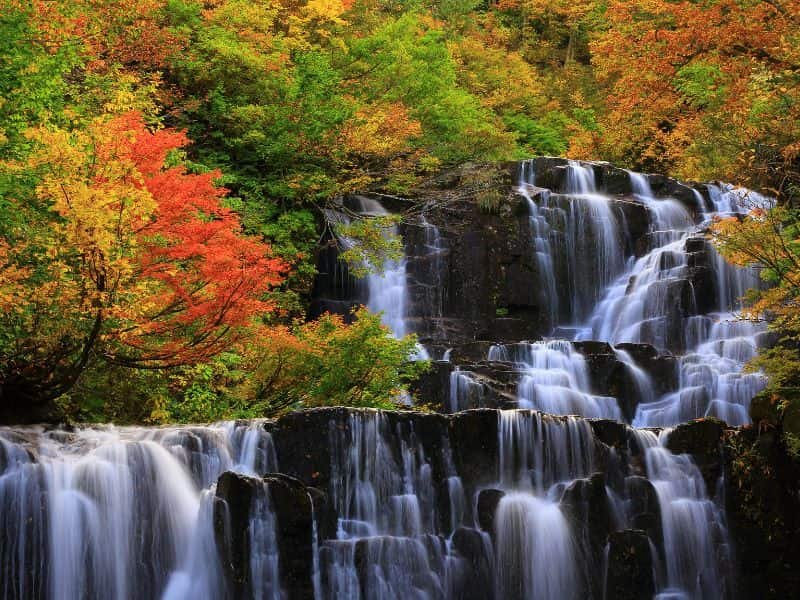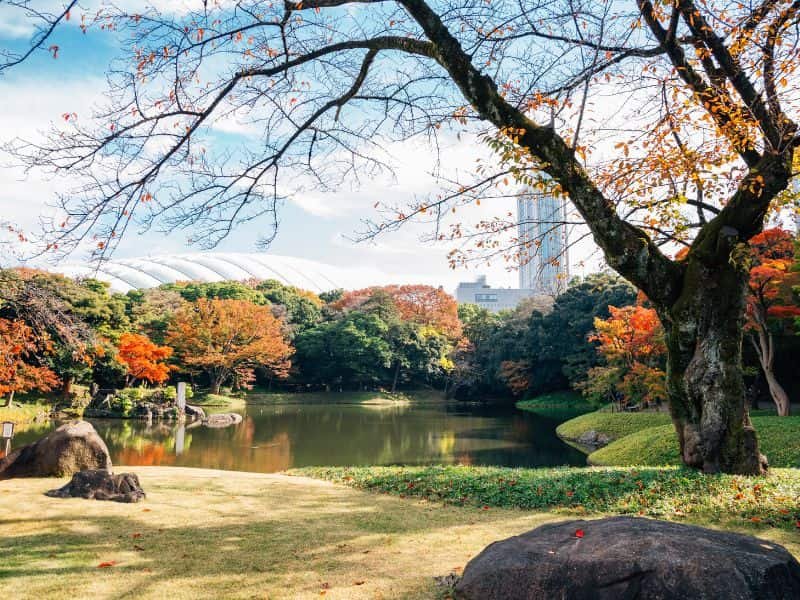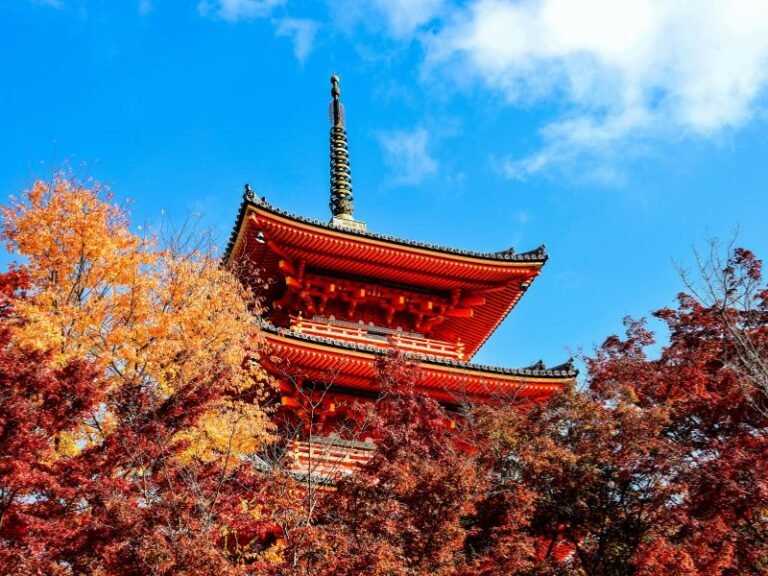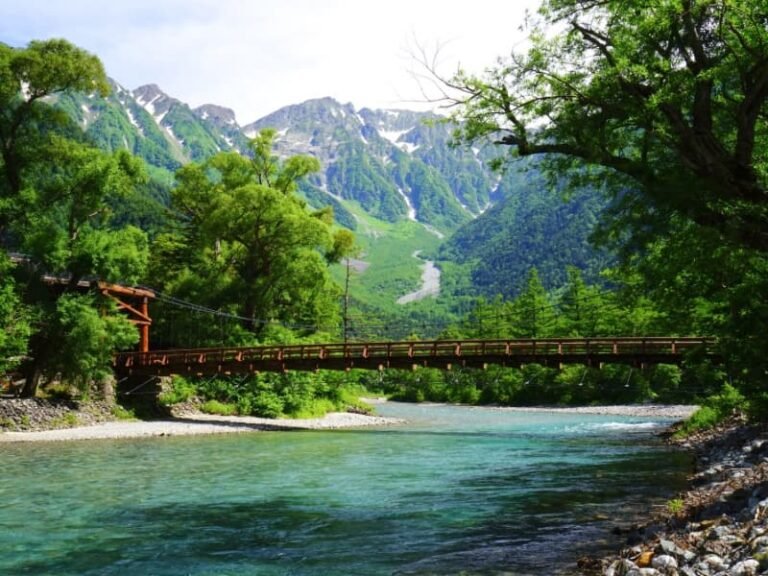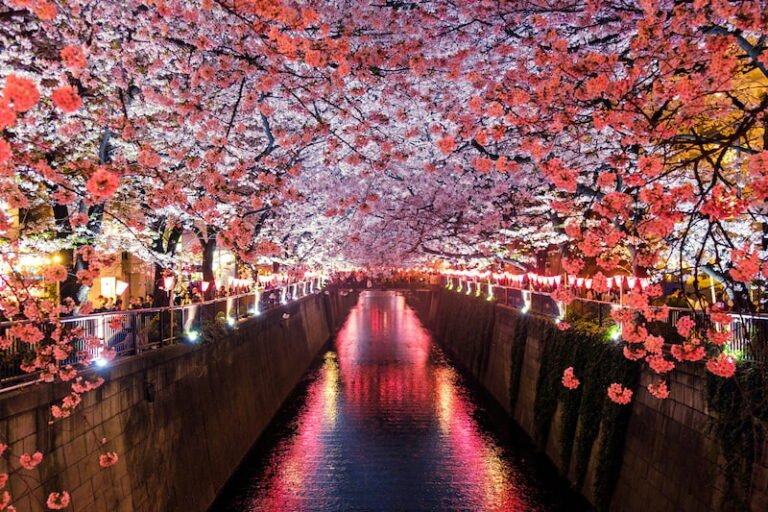7 Days Japan Itinerary: North & Central Routes for great Fall Foliage
Planning a trip to Japan in autumn? You’re in for a treat.
Fall is one of the best times to visit Japan, with vibrant foliage, crisp air, relaxing onsen, and beautiful landscapes everywhere you go.
In this post, I’ve created two detailed 7-day Japan itineraries that cover the best places to see autumn leaves in Japan’s northern and central regions. Whether you’re dreaming of peaceful lakes in Aomori, samurai towns wrapped in maple trees, or scenic villages in the Japanese Alps, these routes are ideal for first-time or second-time visitors looking to experience the beauty of Japan in October and November.
Each Japan itinerary includes local tips, transport details, and cultural highlights to help you plan your journey with confidence.
7-Day Northern Japan Itinerary in Autumn: Nature, Onsen & Culture

Day 1: Tokyo to Aomori – Your Northern Adventure Begins
Once you land in Tokyo, hop on the Tohoku Shinkansen and head north to Shin-Aomori Station (about 3.5 hours). You’ll notice the landscape changing as you leave the city and enter the beautiful countryside.
Spend the evening in Aomori City or nearby Hachinohe and get ready for a nature-filled day tomorrow!
Day 2: Explore Oirase Gorge (奥入瀬渓谷) & Lake Towada(十和田湖)
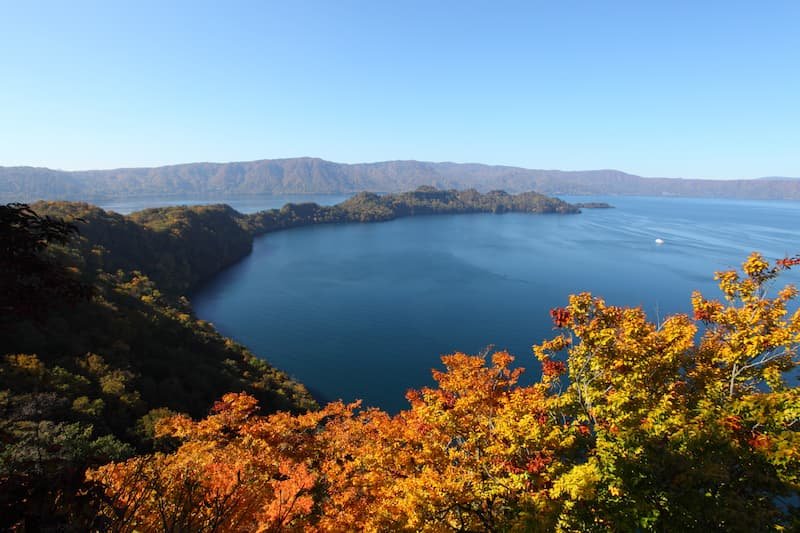
🚌 Transportation: JR Bus from Aomori to Oirase Stream (1 hour 30 minutes)
One of the most scenic spots for autumn in Japan, Oirase Gorge is filled with clear streams, mossy rocks, and waterfalls surrounded by golden and red leaves. The walking trail along the river is mostly flat and easy to enjoy.
After your hike, head to Lake Towada, a peaceful crater lake with a quiet, reflective surface — a great place for a boat ride or lakeside stroll.
Day 3: Hakkoda Mountains Ropeway (八甲田山ロープウェイ)& Sukayu Onsen(酸ヶ湯温泉)

🚌 Transportation: JR bus from Lake Towada area to Hakkoda Ropeway (45 minutes)
Start the day by riding the Hakkoda Ropeway, where you’ll soar above slopes of golden and crimson trees. It’s one of the best places in Aomori for panoramic autumn views, especially in early to mid-October when the foliage peaks.
After your mountain adventure, it’s time to slow down and soak — literally — in one of Japan’s most famous hot springs: Sukayu Onsen.
Sukayu is known for its huge wooden bathhouse called the “Senjin-buro” (1,000-person bath), which is actually a konyoku (mixed-gender bath). That might sound surprising — and honestly, it was for me too!
My Story at Sukayu Onsen
The first time I visited, I didn’t realize the bath was mixed. I walked in as usual — naked — and was shocked to see many gentlemen already relaxing in the giant tub. I froze, completely unsure what to do, and quietly turned back to the changing room.
I was young and totally confused! But then, a kind elderly lady gave me gentle advice:
“Just walk straight into the bath with your towel in front of you. The water is milky-white, so once you’re in, no one can see your body.”
So I took a deep breath, followed her advice, and ended up loving the experience. The warm, sulfur-rich water and the rustic wooden building created a truly special atmosphere. It felt like stepping back in time.
Good news for those unsure about mixed bathing
Sukayu Onsen now offers a ladies-only time every morning, and you can also rent a bathing cloth if you’d prefer to cover up. So there’s no need to worry — anyone can enjoy this beautiful onsen comfortably.
🏨 Staying overnight at Sukayu’s traditional inn is highly recommended if you want the full mountain onsen experience.
Day 4: Journey to Nyuto Onsen (乳頭温泉郷), Akita
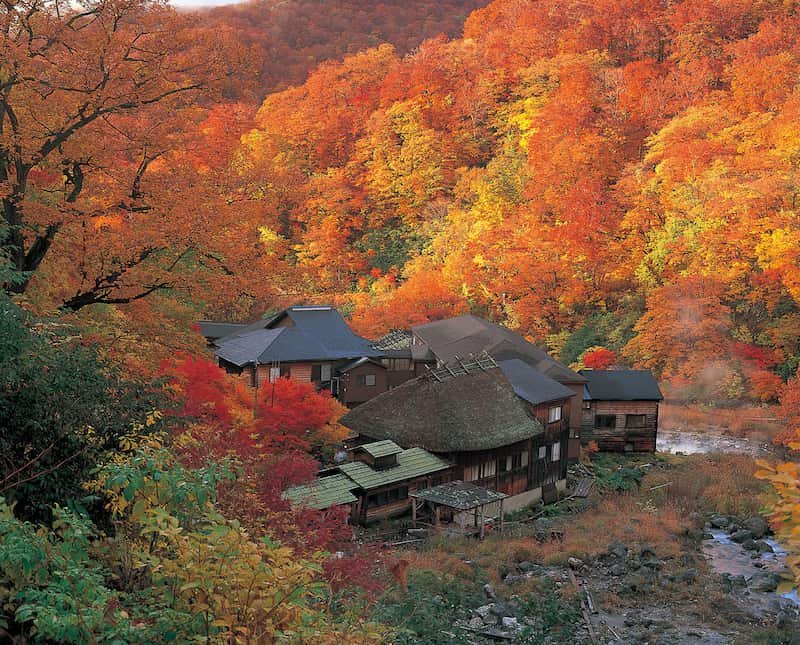
🚌 Transportation: Take the train from Aomori to Tazawako Station (via Shin-Aomori → Morioka → Tazawako), then take a local bus or ryokan shuttle to Nyuto Onsen.
Today, head to Nyuto Onsenkyo in Akita Prefecture, a quiet mountain area with seven different onsen ryokan, each with their own unique character. The area is especially beautiful in late October, when the forest around the baths turns red and gold.
Nyuto Onsen (乳頭温泉)is like stepping into a fairy tale. This secluded hot spring village is actually a collection of seven distinct onsen ryokans, each with its own unique character and natural hot spring source. The best part? You can visit all seven with a special shuttle bus that connects them all!
Here’s what makes each one special:
Tsurunoyu Onsen (鶴の湯)is the most famous and oldest (over 300 years!). There are 4 f different type of hot spring sources. You can enjoy one big roten-buro(Open air onsen).
Kuroyu Onsen (黒湯温泉)offers a more rustic experience with its traditional wooden buildings. The name means “black hot water” The outdoor bath here feels like soaking in a natural forest pond.
Ganiba Onsen (蟹場温泉) Name meaning: “Crab place” (locals used to find crabs in the stream). Four type of Onsen include mix-type.
Magoroku Onsen (孫六温泉)has been renewed in June 2025. You can enjoy wonderful onsen and brand new facilities.
Taenoyu Onsen (妙の湯)lTaenoyu Onsen is a traditional mountain inn in Akita’s Nyuto Onsenkyo. There are two different onsens. One is Kin-no-yu (金の湯),this is mixed type and located out side (Roten-buro) and another is Gin-no-yu(銀の湯), located inside.
Kyukamura(休暇村) is the most modern facility, perfect if you want onsen experiences with more amenities and comfort.
Ookama Onsen(大釜温泉)Housed in a renovated old school building! The facility is very historical type so you might be able to enjoy old Japanese era.
Getting Around Nyuto Onsenkyo
- Use the “Yumeguri-go” shuttle bus — it loops through all 7 onsen.
- The Yumeguri Passport (¥1800) gives you entrance to 3 onsens of your choice, valid for 6 months.
- Buses leave from Tazawako Station, and many ryokan offer shuttle pickups with advance booking.
Tips for Visitors
- Bring a small towel for onsen-hopping.
- Most onsen are cash only and may not have English signage.
- It’s best to stay at least one night in the area to truly enjoy the atmosphere.
Not sure how to use Onsen ? step by step guide -> Click here
Day 5: Hachimantai(八幡平) & Kakunodate Samurai Town (角館武家屋敷)

🚌 How to Get from Nyuto Onsen to Hachimantai:
From Nyuto Onsen, take a bus or shuttle to Tazawako Station (about 50 minutes). From Tazawako, board the JR Tazawako Line to Morioka Station (around 45 min). Then, transfer to the JR Hanawa Line and ride to Appi-Kogen Station (approx. 1 hr 30 min).
From Appi-Kogen Station, you can take a local bus or taxi to reach Hachimantai’s scenic spots, such as Hachimantai Aspite Line, Hachimantai Summit Park, or Matsukawa Onsen.
Hachimantai(八幡平)
After a peaceful night at Nyuto Onsen, start your day with a trip to Hachimantai, a highland region known for its wide-open landscapes, volcanic plateaus, and brilliant fall foliage.
The area is especially stunning in late September to mid-October, making it one of the first places in Japan to experience the changing leaves.

What to Do in Hachimantai:
- Take in sweeping mountain views from Hachimantai Panorama Line
- Walk short trails near the Hachimantai Summit Resthouse
- Visit dragon-eye-like crater lakes and peaceful alpine wetlands
- Relax in rustic hot springs like Matsukawa Onsen
The whole area is calm, uncrowded, and full of fresh mountain air — a perfect hidden gem for autumn lovers.
🚃 How to Get from Hachimantai to Kakunodate:
From Hachimantai (Appi-Kogen), return to Morioka Station via the JR Hanawa Line (approx. 1 hr 30 min).
Then transfer to the Akita Shinkansen and ride to Kakunodate Station (about 40 min)
Kakunodate Samurai Town (角館武家屋敷)
Once in Kakunodate, spend the afternoon exploring its beautifully preserved samurai district, filled with black-lacquered fences, traditional homes, and fiery red maple trees.
Walk along the Bukeyashiki Street, visit historical residences, and stop by cafes and local craft shops. It’s peaceful and perfect for autumn strolls.
🏨 Stay overnight in Kakunodate or nearby Tazawako for an easy trip to Naruko Gorge tomorrow!
Day 6: Explore Naruko Gorge – One of Tohoku’s Best Fall Foliage Spots
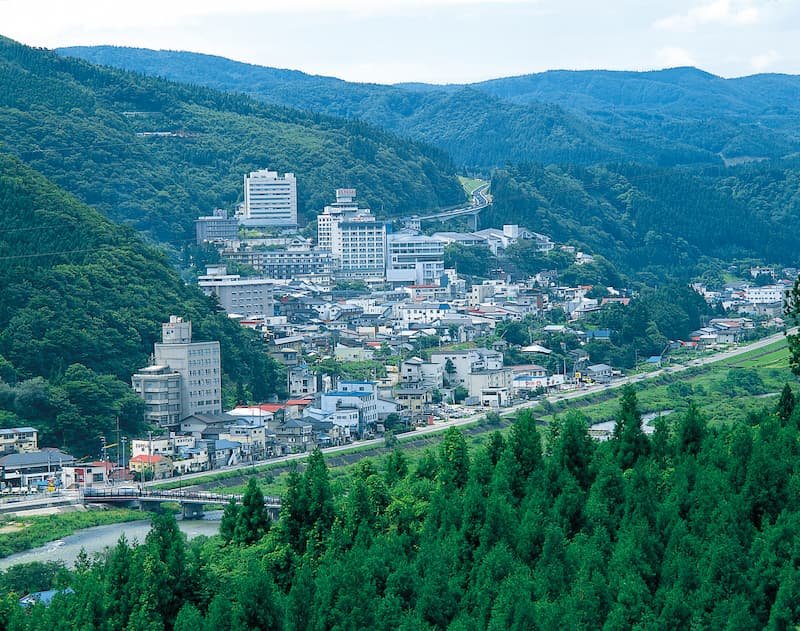
How to Get from Kakunodate to Naruko
From Kakunodate, take the Shinkansen to Sendai (~1.5 hrs), then ride the JR Rikuu East Line to Naruko Onsen Station (~70–90 mins). The gorge is a short bus or taxi ride away.
After a relaxing morning, make your way south to Naruko Gorge, one of the most scenic places in all of Tohoku during autumn. The cliffs, bridges, and river views are unforgettable!
Enjoy a walk along the gorge’s trail or take in the view from the famous pedestrian bridge. Fall colors usually peak in late October to early November.
Fun tip: Naruko is one of the top producers of traditional kokeshi dolls. If you’re interested in Japanese crafts, check out the Kokeshi Museum or pick up a souvenir!
Day 7: Return to Tokyo or Continue to Kyoto
Depending on your travel plans, you can head back to Tokyo by Shinkansen (about 1.5–2 hours from Sendai), or continue your journey to Kyoto if you’re exploring more of Japan.
Itinerary 2: Central Japan Itinerary in Autumn (Mid–Late October)
This 7-day trip is perfect for travelers who want to see the best of Japan’s autumn colors without zigzagging across the country. Starting in Tokyo and ending with optional Nikko, this route includes Mt. Fuji views, scenic valleys, historic villages, and elegant cities.
Day 1: Arrive in Tokyo → Explore Autumn Gardens
Welcome to Japan! Start your trip with a peaceful stroll through one of Tokyo’s traditional gardens, which begin to show early autumn colors in late October.
First time in Tokyo? Learn how to ride the trains – step by step- Click here
Where to go
- Koishikawa Korakuen 小石川後楽園 (near Iidabashi Station): A beautiful landscape garden with maple trees around a pond.
- Rikugien Garden 六義園 (near Komagome Station): Known for its maple tunnel and poetic atmosphere.
🛏️ Stay in Tokyo tonight to prepare for your countryside adventure tomorrow.
Day 2: Explore the Fuji Five Lakes(富士五湖) – Mt. Fuji Views & Fall Colors
Today, head to Lake Kawaguchi, the most popular of the Fuji Five Lakes, and enjoy amazing views of Mt. Fuji framed by autumn leaves. This is one of the best places in Japan to experience fall foliage and Mt. Fuji in one shot — especially from late October to mid-November.

🚃 How to Get from Tokyo to Lake Kawaguchi (Kawaguchiko Station)
Option 1: Limited Express from Shinjuku (fastest & easiest for tourists)
- Take the Limited Express “Fuji Excursion” from Shinjuku Station directly to Kawaguchiko Station.
- Takes about 1 hour 50 minutes
- Runs a few times daily(Note: Only morning from Shinjuku) and connects smoothly (no transfers needed)
Option 2: Regular Route via Otsuki (more flexible schedule, JR Pass partially usable)
- From Shinjuku, take the JR Chuo Line to Otsuki Station (about 70–90 minutes)
Transfer to the Fujikyu Railway (e.g., Fujisan View Express) from Otsuki to Kawaguchiko (about 55 minutes)
Note: The JR Pass covers the train to Otsuki, but the Fujikyu line to Kawaguchiko is not covered. Please make sure the time schedule before you go because these trains are limited.
What to Do Around Lake Kawaguchi
- Momiji Corridor (Maple Corridor) – A stunning walking path lined with colorful maple trees. Don’t miss this during peak season!
- Fuji Panoramic Ropeway (Kachi Kachi Ropeway)– Ride to the top of Mt. Tenjo for panoramic views of Mt. Fuji and the lake. You can ride cute designed Ropeway based on the Kachi Kachi Yama story.
- Kawaguchiko Music Forest Museum – A lovely museum with a European feel and a Mt. Fuji backdrop.
- Onsen Experience – Relax in a hot spring bath with Mt. Fuji views. Many ryokan and hotels offer day-use options too!
What Are the Fuji Five Lakes?
The Fuji Five Lakes (Fujigoko) are a group of scenic lakes located at the base of Mt. Fuji in Yamanashi Prefecture, formed by past eruptions of the volcano. These lakes offer some of the best views of Mt. Fuji, especially in autumn when colorful leaves reflect beautifully on the water.
They’re also great for relaxing walks, boat rides, museums, and traditional inns. You don’t need to visit all five — here are the most popular and convenient ones for first-time travelers:
1. Lake Kawaguchi (河口湖)
- Most accessible from Tokyo
- Offers iconic views of Mt. Fuji, especially from the northern shore
- Great spot for hot springs, museums, and cafes
💡 Tip: This is the lake I recommend if you only have one day in the area!
2. Lake Saiko(西湖)
- More peaceful and surrounded by forest
- Try canoeing or walking trails along the lake
- Good choice for nature lovers
3. Lake Yamanakako(山中湖)
- Known for cycling paths and swan boats
- Popular with photographers for wide-open views of Fuji
4. Lake Shojiko(精進湖) & 5. Lake Motosuko(本栖湖)
- Smaller and farther, less developed
- Best for those seeking quiet escapes or driving around the area
Day3 : Matsumoto(松本) & Narai-juku (奈良井宿)– Castles and Edo Townscapes
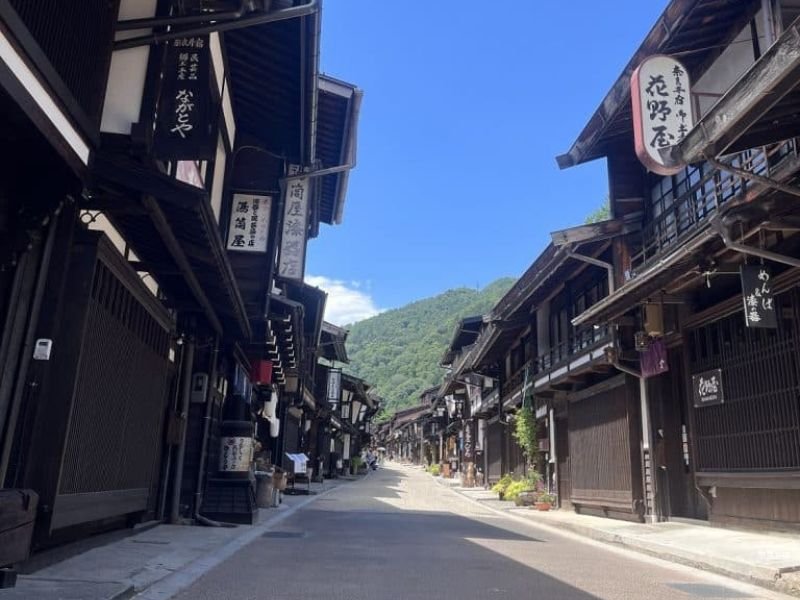
Looking for a quieter, more local autumn experience? Today, leave Mt. Fuji behind and head into the Japanese Alps to discover the charming castle town of Matsumoto and the nostalgic Edo-era post town of Narai-juku. It’s a perfect balance of history, fall foliage, and scenic townscapes — all in one day.
🚃 How to Get there
From Lake Kawaguchi to Matsumoto
- Take the Fujikyu Railway from Kawaguchiko Station to Otsuki Station (approx. 55 min)
- Transfer to the JR Chuo Line and ride to Matsumoto Station (approx. 2.5–3 hours total)
FromMatsumoto to Narai-juku (optional)
- Take the JR Chuo Line from Matsumoto Station to Narai Station (approx. 1 hour)
- The post town is right outside the station — no bus needed!
What to Do in Matsumoto
Visit Matsumoto Castle (Crow Castle)
Matsumoto Castle is Nicknamed the “Crow Castle” for its black walls, this 16th-century castle is one of Japan’s few remaining original castles. In autumn, it becomes even more beautiful with golden and red trees reflecting in the moat. You can also go inside to climb its steep wooden steps and enjoy panoramic views.
Stroll Along Nakamachi Street
Just a short walk from the castle, this historical shopping street is lined with white-walled storehouses (kura) that now house local shops, cafés, and craft stores. It’s a nice place to pick up wasabi goods (a Nagano specialty) or try handmade soba noodles for lunch.
Optional Side Trip: Narai-juku(奈良井宿)
If you want to step back in time, take a half-day trip to Narai-juku, one of the best-preserved post towns along the old Nakasendo Trail. The long street is lined with traditional wooden inns, tea houses, and shops, with mountains glowing in fall colors all around.
It’s less touristy than places like Magome or Tsumago, making it a peaceful retreat in autumn.
💡 If you love photography, quiet walks, and old-Japan vibes, Narai-juku is worth the side trip.
Day 4: Step into a Storybook Village in Shirakawa-go(白川郷)
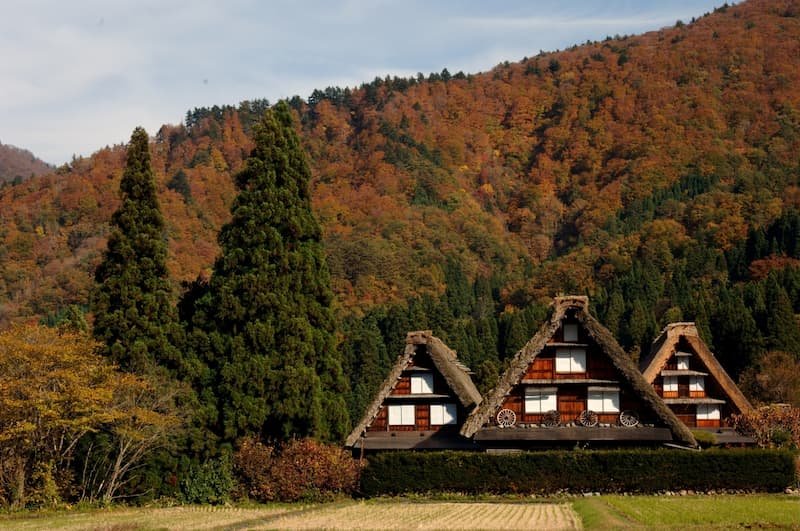
Today, you’ll journey into the mountains of Gifu Prefecture to visit one of the most picturesque places in Japan — Shirakawa-go, a UNESCO World Heritage village. Known for its unique thatched-roof farmhouses and peaceful mountain scenery, it becomes especially magical during the fall foliage season when the surrounding forests glow in shades of red, yellow, and gold.
🚃 From Matsumoto to Shirakawa-go
- Take the JR Limited Express train from Matsumoto Station to Takayama Station (approx. 2.5 hours).
- From Takayama, take the Nouhi Bus (濃飛バス)to Shirakawa-go Bus Terminal (approx. 50 minutes)
- Make sure to book your bus tickets in advance, especially during foliage season!
What to Do in Shirakawa-go
Explore the Gassho-Zukuri Houses
Shirakawago(白川郷) is famous for its traditional gassho-zukuri houses — their steep, triangular roofs resemble hands pressed together in prayer (“gassho”合掌). You can go inside some of them, like Wada House, to learn how families lived in this remote region for centuries.
Walk to the Shiroyama Viewpoint
Take a short uphill walk (about 15–20 minutes) or shuttle to the Shiroyama Tenshukaku Observation Deck (城山天守閣展望台)for a panoramic view of the entire village. It’s especially beautiful in autumn when the thatched roofs are surrounded by colorful forests.
Try Local Foods & Souvenirs
Warm up with Hida beef croquettes, local miso soup, or mountain vegetable dishes. There are also charming shops selling handmade crafts, dried fruits, and seasonal items.
Day 5: Culture, Gardens, and Gold Leaf in Elegant Kanazawa(金沢)
After your peaceful escape to the mountains, it’s time to head to Kanazawa — a beautiful city known for its art, traditional districts, and one of Japan’s top three gardens. In autumn, the city offers a wonderful mix of culture and seasonal beauty, all at a relaxed, easygoing pace.

🚃 How to get From Shirakawa-go to Kanazawa
- Take the Nouhi Bus(濃飛バス) from Shirakawa-go Bus Terminal to Kanazawa Station (approx. 1 hour 15 minutes).
Buses are limited, so it’s best to reserve in advance.
What to Do in Kanazawa
Stroll Through Kenrokuen Garden(兼六園)
This famous garden is the crown jewel of Kanazawa and truly shines in the fall. You’ll see a blend of maple trees, stone lanterns, ponds, and charming teahouses. Don’t miss the traditional yukitsuri (ropes protecting pine trees from snow), which start appearing around mid-November.
Kenrokuen is especially stunning around the Kasumiga-ike Pond during peak foliage season.
Visit Kanazawa Castle(金沢城)
Right next to Kenrokuen is Kanazawa Castle, with its white walls and spacious park. You can explore the reconstructed gates and towers, or just enjoy the open lawns and tree-lined paths painted in yellow and orange during autumn.
Wander the Higashi Chaya District(ひがし茶屋街)
This historic geisha district features old wooden tea houses, cute cafes, and gold leaf shops. Try some gold leaf soft-serve or stop by Kaikaro Teahouse, where you can experience the elegance of traditional Japanese architecture.
Bonus: 21st Century Museum of Contemporary Art (金沢21世紀美術館)
If you’re interested in modern art and unique architecture, this popular 21st Century Museum is just a 10-minute walk from Kenrokuen. A fun contrast to Kanazawa’s historical side!
Day 6: Elegant Autumn Strolls in Karuizawa(軽井沢), a Resort Town in the Forest
Today, head to Karuizawa, a stylish mountain resort town that’s popular for its cool weather, fall foliage, boutique shops, and relaxing nature. It’s especially beautiful in late October to early November, when the tree-lined paths turn golden and fiery red.
Karuizawa has long been a retreat for artists, writers, and even royalty. It’s the perfect place to enjoy nature at a slow pace, sip coffee in a cozy café, and take a breath before your final day.

🚃 How to get From Kanazawa to Karuizawa
- Take the Hokuriku Shinkansen from Kanazawa Station to Karuizawa Station (approx. 1 hour 45 minutes).
- This direct ride on the bullet train is easy and scenic — enjoy views of the Japan Alps along the way!
What to Do in Karuizawa
Stroll Around Kumoba Pond (雲場池)
Kumoba Pomd is the one of the best foliage spots in Karuizawa! The calm waters of this small pond reflect the brilliant autumn colors. It’s an easy 20-minute loop trail, perfect for a peaceful morning or late afternoon walk.
Visit Shiraito Falls(白糸の滝)
A short bus or taxi ride away, Shiraito Falls (literally “white threads”) flow like a soft curtain from the forest. The area becomes a colorful wonderland in fall and is one of Karuizawa’s hidden gems.
Explore Kyu-Karuizawa(旧軽井沢) Shopping Street
Kyukaruizawa has full of charming cafes, antique stores, and specialty shops. Try a slice of fresh apple pie or shop for Karuizawa-made jam and local wine.
Karuizawa gets chilly in the fall — don’t forget a warm scarf or jacket!
Stay overnight in Karuizawa, where you’ll find boutique hotels, pensions, and elegant resort-style accommodations. Some hotels even offer forest views and fireplaces, perfect for a cozy autumn night.
Day 7: Optional Day Trip to Nikko(日光) – Nature, Temples & Autumn Glor
If you have one more day before flying home, we highly recommend a day trip to Nikko — one of Japan’s best destinations for fall colors and spiritual culture. Located in Tochigi Prefecture, Nikko is famous for its UNESCO World Heritage shrines, misty forests, and mountain lakes.
Because it’s nestled in higher elevation, Nikko’s leaves usually peak in mid to late October, making it a perfect finale for your autumn adventure.
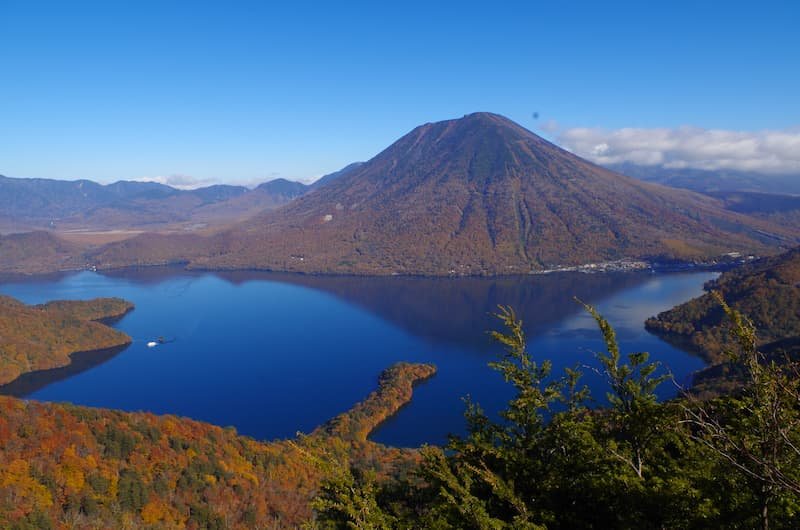
🚃 How to get From Karuizawa to Nikko (via Tokyo)
- Take the Hokuriku Shinkansen from Karuizawa Station to Tokyo Station (about 1 hour 15 minutes).
- From Tokyo, head to Asakusa Station and take the Tobu Limited Express “SPACIA X” or “Kegon” to Tobu Nikko Station (approx. 2 hours).
- We recommend the Tobu Line from Asakusa because it has frequent direct trains to Nikko and is easy to use for tourists.
NOTE: A day trip is possible if you start early, but you can also stay overnight in Nikko for a more relaxed experience.
What to Do in Nikko
Visit Nikko Toshogu Shrine(日光東照宮)
Nikko Toshogu is the resting place of Tokugawa Ieyasu, the first shogun of Japan. Surrounded by tall cedar trees and vibrant maple leaves in fall, it’s one of the most iconic cultural spots in the country.
Explore Lake Chuzenji (中禅寺湖)& Kegon Falls(華厳の滝)
Take a bus up the winding Irohazaka road (いろは坂)to reach Lake Chuzenji, a peaceful lake at the foot of Mt. Nantai. In autumn, the lake is wrapped in flaming red and gold trees. Nearby, Kegon Falls (97 meters high!) adds a dramatic touch to the landscape.
🚌 The area around Lake Chuzenji is one of the best places in Japan for fall foliage — don’t skip it if the timing works!
Grab a Snack at Nikko’s Old Town Streets
Stroll the historic shopping street near the station, where you can try local specialties like yuba (tofu skin 湯葉), manju 饅頭 (sweet buns), and Nikko-brewed craft beer or cider.
Travel Tip
If you’re short on time or departing Japan today, you might skip Nikko and enjoy a relaxing morning in Karuizawa instead — perhaps another peaceful walk around the pond or shopping at the Karuizawa Prince Shopping Plaza before heading back to Tokyo.
Conclusion
I hope these itineraries help you fall in love with Japan’s autumn season as much as I have. From colorful gorges in the north to quiet temples and historic towns in central Japan, this is one of the most magical times to travel the country.
Whichever route you choose, you’ll enjoy not only the vibrant scenery but also warm onsen baths, delicious seasonal food, and plenty of local charm.
Enjoy trip to Japan!
